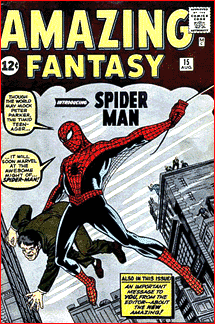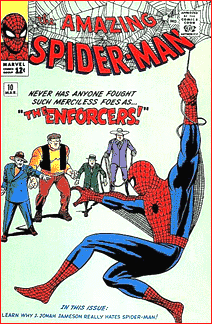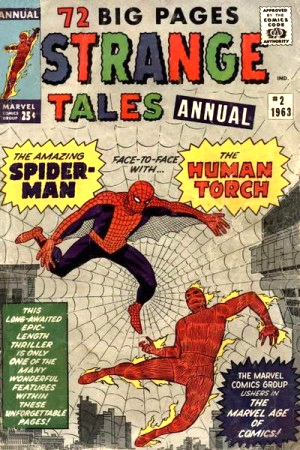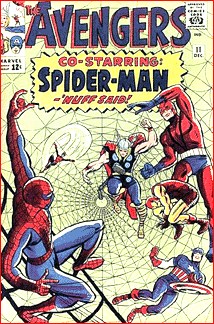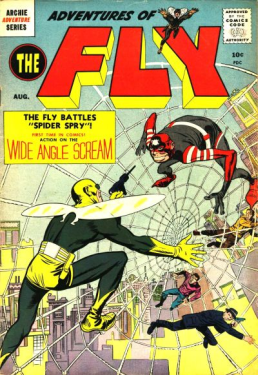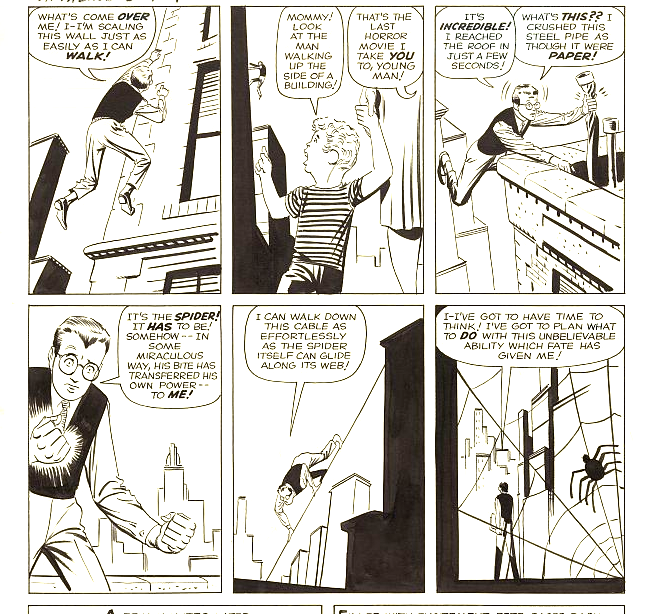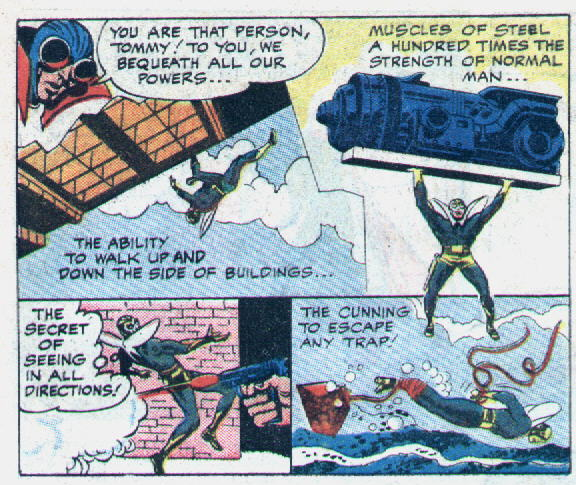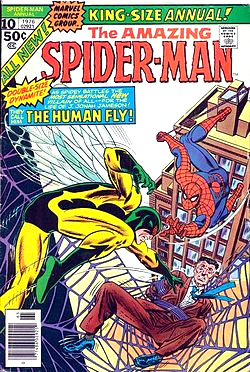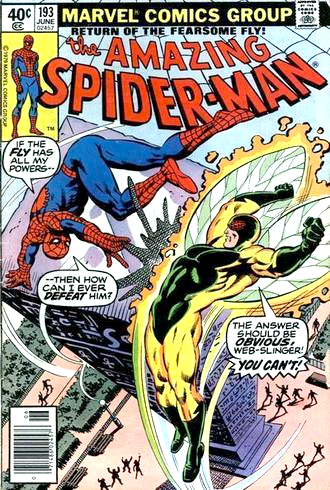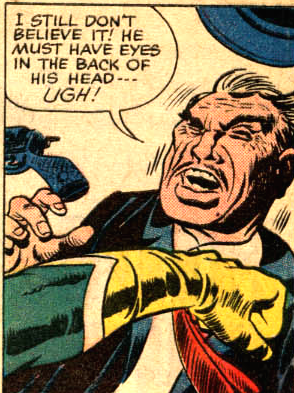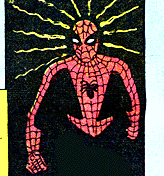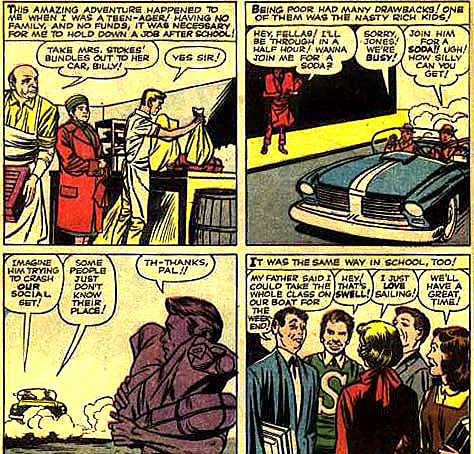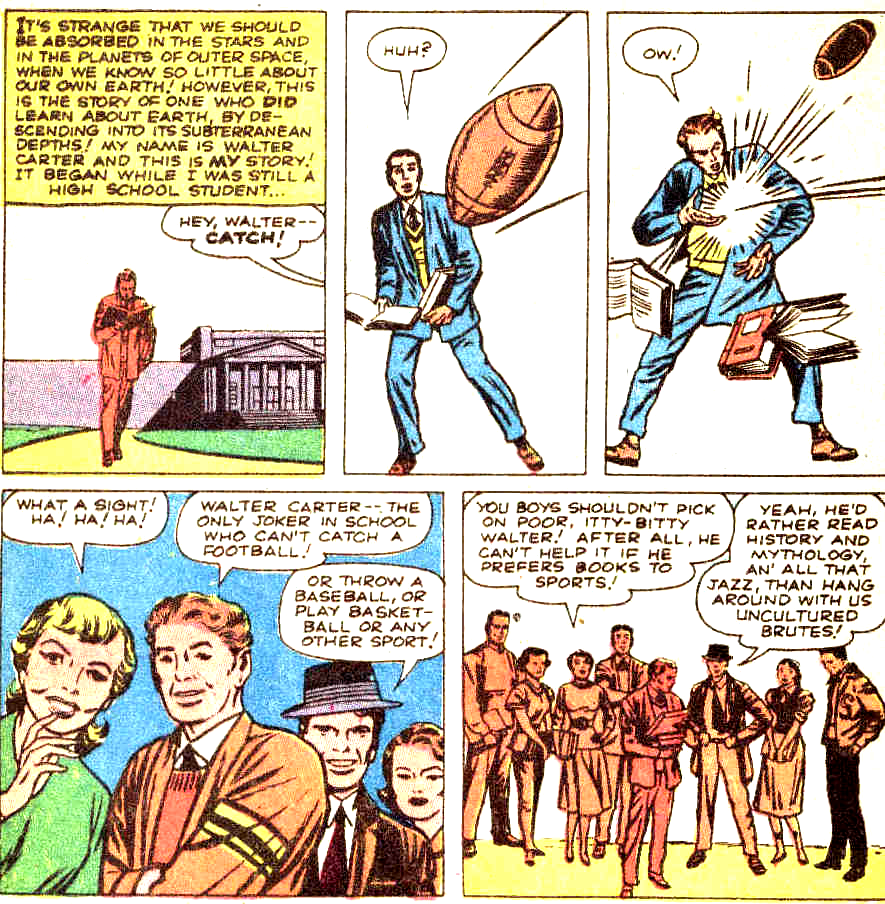Previous – 18. New Beginnings | Contents | Next – 20. Bullpen? Bullshit!!
We’re honored to be able to publish Stan Taylor’s Kirby biography here in the state he sent it to us, with only the slightest bit of editing. – Rand Hoppe
SPIDER-MAN: THE CASE FOR KIRBY
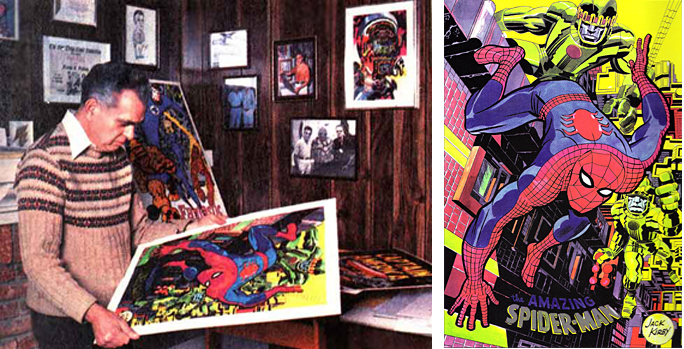
In Feb. or March of 1962, Stan Lee pulled Steve Ditko aside, he explained that the next issue of Amazing Fantasy (#15) would feature a new super-hero. “He would be called Spider-Man. Jack would do the penciling and I was to ink the character” “Stan said Spider-Man would be a teenager with a magic ring which would transform him into an adult hero-Spider-man. I said it sounded like the Fly, which Joe Simon had done for Archie Publications.” Steve recalled.
“Stan called Jack about it but I don’t know what was discussed. I never talked to Jack about Spider-Man, so I don’t know what his ideas concerning the characters actually were.” Later at some point I was given the job of drawing Spider-Man. Why, exactly? Stan and Jack also have to clear that up.”
Stan Lee says that Spider-Man came to him one night when he saw a spider walking on a wall, and the name Spider-Man derived from a favorite pulp fiction character from his youth- The Spider.
Not surprisingly, Kirby has a different tale to tell. In an interview with Will Eisner, Kirby described the genesis thusly: “It was the last thing Joe and I discussed. We had a strip called The Silver Spider. I believe I said this could become a thing called Spiderman, see, a super-hero character. So the idea was already there when I talked to Stan. He would also explain that at the time he was very busy so after a few introductory pages they turned the character over to the planned inker to pencil and ink. “Stan Lee gave it to Steve Ditko because I was doing everything else; until Johnny Romita came in to take up some slack. There were very few people at Marvel; Artie Simek did all the lettering and production.” When Ditko took over, he and Lee added in their own take on the character. Of the three, only Kirby provided any specifics as to where the inspiration came from.
There was heavy blowback and discussion about Jack’s claims though they weren’t new. As early as 1968 Jack claimed design aspects of Spider-Man as being taken from his earlier work. His portfolio Kirby Unleashed, (1970) had this to say in the biography by Mark Evanier. “Spider-Mans beginnings, however date back to when Simon and Kirby had their own publishing company and were devising new characters for it….they had a projected character named Spiderman…recalling the name, Kirby suggested it to Marvel..” Even in a Marvel in-house article from FOOM #11, (1975) the writer Alex Boyd says; “It’s not generally known that it was Jack Kirby who designed Spider-Man’s costume.” I have read, many strange attempts at twisting those words to refute what was written, but they can’t change the date and now make the claim that Kirby’s claims were made during a period of great anger at Marvel. It was always Kirby’s claim that Jack presented the idea of Spider-Man to Stan Lee. I think the clearest evidence came from an article from Comics Scene magazine#2 (March 1982) by Howard Zimmerman. Jack says; “I did a mess of things. The only book I didn’t work on was Spider-Man which Steve Ditko did. But Spider-Man was my creation.”
Several different versions, at odds with each other, how do we find out the truth? The first thing is to remember the routine that Lee and Kirby had established. Jack was responsible for the characters and plot elements. And Lee the personalities and human attributes. Is there any evidence that Spider-Man should be any different? No, in fact it makes sense with Ditko’s memories of Jack Kirby being involved before he was, and as the preferred penciller.
Who you gonna call?
It was also Jack’s method to refer back to previous recent creations for inspiration. He had done this for the Rawhide Kid, The Fantastic Four, The Hulk, and Thor, Ant-Man and Sgt. Fury. There is no reason to expect anything different with Spider-Man. The best clue may be Ditko’s observation that the original concept was identical to Archie’s Fly- created by Simon and Kirby just a couple years earlier- though Ditko had not remembered Kirby’s participation. And what do we know about the Fly? That the Fly evolved from a Kirby drawn character called Spiderman, which evolved from Joe Simon’s Silver Spider.
What’s the diff? Fly Spider Fly?
But it’s not very scientific to just pick Ditko’s reminiscence and accept it at face value, or Stan’s or Jack’s. If we can’t rely on first-person testimony, what can we do? The Confessor, in Kurt Busiek’s Astro City said it best, “Look at the facts, look at the patterns, and look for what doesn’t fit. Base your deductions on that.”
It has been said, “an artist is someone who pounds the same nail over and over again.” All artists, graphic or literary, have patterns. They repeat aspects, concepts, a style of punctuation, a brush stroke, lines of musculature, anything that separates their style from the hundreds of others. When trying to identify an unknown artist, one can compare the piece in question with other contemporaneous works to match up these patterns. This method has been used to research everything from Shakespeare’s writings to the works of the Great Art Masters. I have spent a lot of time in this text showing the predecessors to Jack’s creations. This pattern is so strong that it can be found from his earliest work all the way to his final works. Jack built his legacy by continually connecting dots yet keeping it fresh.
Can this be used on comic books? Yes, it can, and has. Martin O’Hearn is a noted comic’s historian who specializes in the identification of unaccredited comic writers. He matches up subject, syntax, punctuation, themes and other identifiable patterns, and has had remarkable success in matching writers to their non-credited stories.
Likewise, Dr. Michael Vassallo, in his never-ending quest to index all Atlas/Timely Publications, spent endless hours comparing drawing and inking styles to identify unaccredited works of comic art. His goal of identifying the unlisted inker on Fantastic Four #1 & 2 has led him to amass a veritable mountain of inking examples to compare to the actual comic art. What he didn’t do is blindly accept personal recollections or corporate identifications at face value. If he did, Dick Ayers or Artie Simek would be incorrectly credited with this work. His quest and methods led to the acceptance of George Klein as that inker.
Rather than focusing on un-provable statements- by men with obvious agendas- made long after the creation of Spider-Man, let’s examine their actual concurrent works to see if we can find a pattern of creation that matched up with the concepts, characters, and plot elements found in Amazing Fantasy #15, plus any physical evidence, and testimony from witnesses independent of the three men. I will mention quotes, but not as evidence as quotes are too self-serving. But if a quote provides a specific bit of info, I will try to track that data down to see if relevant, such as Ditko’s quote mentioning the Fly.
Jack Kirby was an amazing man with an endless imagination, but he was also a man who used and reused his favorites themes. I have already mentioned the stories dealing with radio telescopes and looking for aliens, and how this idea bridged several different companies. We also know that Jack did at least five stories using huge rock heads sunk in the Easter Island coast. These stories also crossed at least four different companies, and he did at least 7 stories of robots or other mindless machines getting intelligence—usually by radiation affecting their cores. Alien children running amok causing havoc to the human population crossed many companies and genres. And this was before Quasimodo, Monsteroso or Machine Man. Jack constantly repeated his sources, though he never told the same story twice, he always fit those themes into stories with different takes and details.
For example; One of Jack’s many repeated premises is the Hollywood movie production where the heroes get invited in and once in find the props are not fake, they are deadly traps meant to kill them by their enemies. A version of this shows up even before Jack teamed up with Joe Simon in Wilton of the West, Jack and Joe used it in a wonderful Captain America story, and when they left for DC they used it in a Boy Commandos, and a Newsboy Legion story. An interesting version showed up in Fighting American. Interesting because it was planned for an unpublished issue, and never saw print until 1965, 4 years after Jack used the exact same sequence in a Fantastic Four story. He would reuse it in different versions on Thor, and a later Captain America. This same premise also shows up in an early Spider-Man. No one can deny that it was a Jack Kirby pattern that he used time and again.
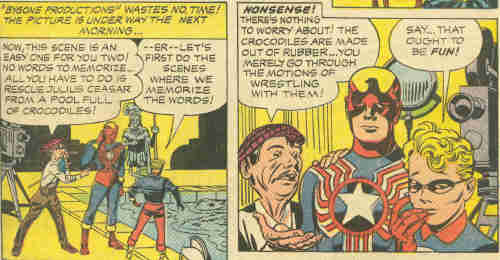
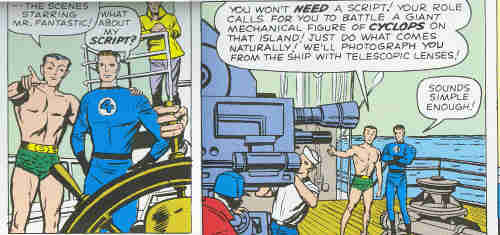
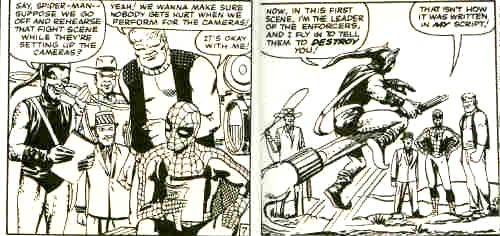
So the best way to begin is to break Spider-Man down to its basic elements and look for matches. The basic concept of Spider-Man is simple, a hero, with the inherent physical powers of a spider- he can crawl up walls, and across ceilings, he has the proportional strength and agility of an arachnid. He has an extra sense that warns him of danger. He manufactures a web shooter that can be used for catching prey, and used as a means of mobility. This was described by Stan Lee when first talking to Steve Ditko.
I could find no earlier character from either Lee or Ditko that had any resemblance to Spider-Man, none. As to Jack Kirby, it didn’t take long to track down a pattern match for the physical aspects of Spider-Man, the surprising factor is just how similar the two characters are. The very character that Steve Ditko claims he recognized when told of the conception. Spider-Man was exactly the same as The Fly.
The very last costumed super-hero book that Kirby produced, prior to Marvel, featured an insect hero able to climb walls and ceilings; had super strength, the agility of a bug, and, amazingly, an extra sense that warned him of danger. Steve Ditko has said that all of this was in place before he got involved. If so, then what was changed from Kirby’s Spider-Man? It seems all the changes were made to Peter Parker, so a full half of the premise remained the same. Ditko made no changes to Spider-Man.
Marvel even noticed a resemblance – The most sensational new villain
In The Adventures of the Fly, (Archie Publications 1959,) Simon and Kirby introduced The Fly, a hero with the exact same insect derived powers that show up in Spidey. In fact, the only physical difference is that the Fly not surprisingly, can fly. The most interesting aspect for me is the match-up of a “sixth sense” to warn of danger. While the other powers (wall climbing, etc.) might be considered generic to any insect hero, (though this isn’t backed up by actual evidence) this warning sense, or insect sensitivity as Archie Publications called it is, as far as I know, something totally unique and beyond the norm of the natural attributes of insects..
The Fly – Spidey
With Spider-Man, his Spidey Sense has two different aspects, the first is a direct warning of an unknown attack, as seen when the Vulture swoops down from behind and his Spidey Sense makes him swerve out of harms way, or when The Invisible Girl tried to sneak up on him. The writers have even described it the same way
Spidey – Mirror images – The Fly
The second aspect is a more vague sense of unease that something bad is about to happen. Like when Spider-Man enters the Tinkerer’s workshop. Ditko shows this extra sense with wavy rays emanating from Spidey’s head. So does the Fly. This was not a onetime aspect, as the Fly stories used it many times.
Coincidentally, the Fly’s extra sense has the exact two aspects as does Spider-Man. It warns him of people sneaking up behind him, such as a punk with a gun and also as a vague vibration bringing a sense of dread alerting the Fly to trouble at the Orphanage. When this is shown in the Fly, he is shown with rays emanating from his head. The addition of this unnatural extra sense and presentation showing up in both creations is just too coincidental. Perhaps the silliest explanation was when a reader, in attempting to show a difference, tried to explain the Fly’s ability as super-hearing. The description in the panel belies this, plus in other uses it was called an “insect sensibility”
It should be noted that the addition of the extra sense that warns of impending danger, first seen in the Fly, seems to have been an original Kirby item, since it was not present in either the Silver Spider proposal, or mentioned in the Jacobson memo.
It’s been said that the Devil’s in the details, and it’s these repeated small details that in my opinion, make the strongest case for Kirby being the concept man.
Does the physical similarity between The Fly and Spider-Man correspond and bolster any specific claims made by the three men? Yes.
It backs up Ditko’s memory, plus it backs up Kirby’s claim that it started with Joe Simon’s Silver Spider which we know evolved into the Fly.
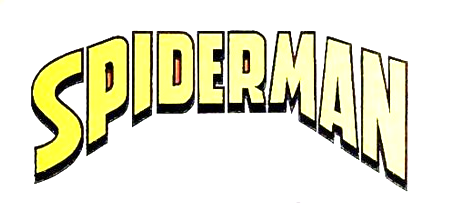
Joe Simon’s logo
Let’s review the step by step process that led from the Silver Spider to Spider-Man. When Archie Publications asked Joe Simon to produce some books for them in 1959, Joe called in Jack Kirby to help out. Joe suggested that they rework his earlier Silver Spider proposal into a character called Spiderman. He handed over a file containing the initial Silver Spider proposal to Jack. The file also contained a rejected working logo. and probably the editorial memos, by Harvey Publications, rejecting the initial proposal. After drawing the first story, the name was changed to the Fly, with changes made to the Kirby drawn story.
According to Joe, in The Comic Book Makers (Crestwood Publications, 1990) when Kirby asked him about specific powers for The Fly, Joe told him “Hey, let him walk up buildings, and let him fly if he wants to, It’s a free country. Take it home and pencil it in your immortal style.” Kirby did just this, and the result was The Fly.
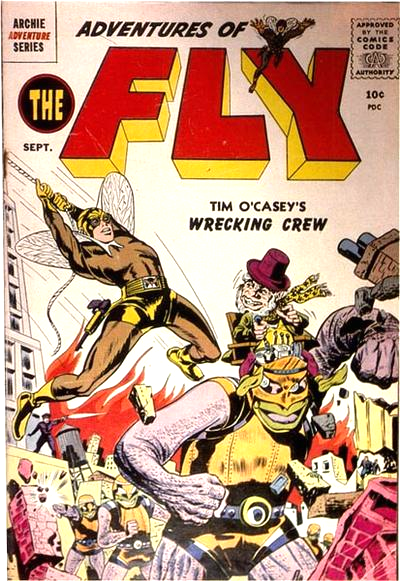
Why is the Fly swinging on a web?
Again, Joe saying The Fly evolved out of the Silver Spider proposal doesn’t make it true. It is when we compare the two stories that we see that aspects of the Fly’s origin gimmick is consistent with the Silver Spider’s. (and Ditko’s later observation) In both stories, the young protagonist (both named Tommy Troy) is a beleaguered orphan who gains his powers via a mystical ring that transforms him into an adult super hero. Yet the super hero character is different. Where the Silver Spider has no apparent powers except enhanced strength, and a great leaping ability, The Spiderman/Fly has been granted very specific powers; inherent insect abilities, (wall clinging, exceptional agility, a sixth sense and a stinger gun- none of which was in the initial Silver Spider proposal. It is this character evolution, supplied by Jack Kirby, that is the borrowed ingredients that later show up in Marvel’s Spider-Man.
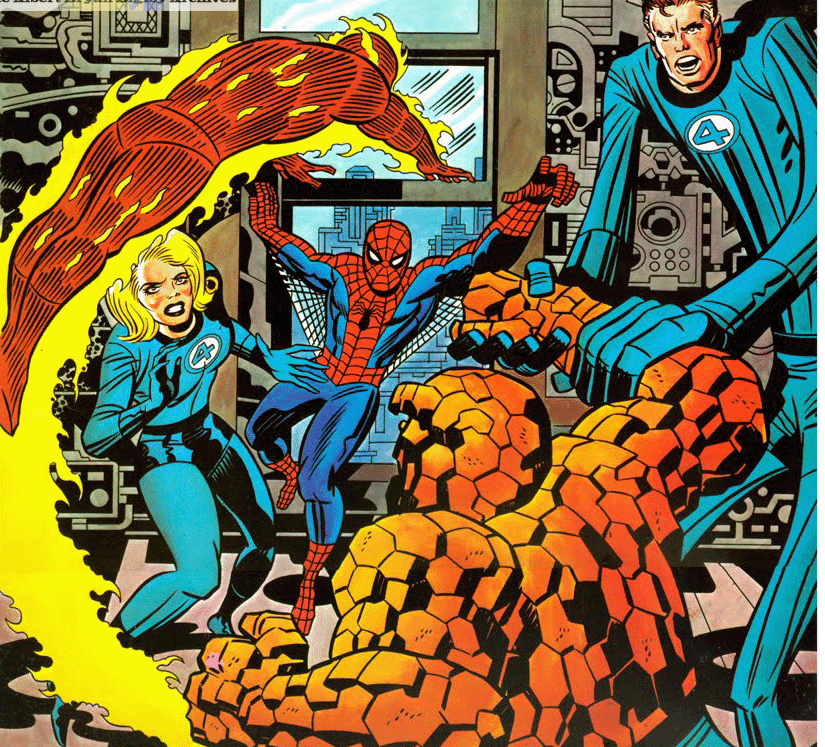
So there is a pattern match that is consistent with Spider-Man and Kirby’s The Fly, and a paper trail that lends credence to Jack Kirby’s claims concerning the initial Silver Spider connection, and Ditko’s claim about the resemblance with the Fly. As an aside, Simon had rejected a working title “Spiderman” for his Silver Spider project, and showed a logo to Kirby, leaving little doubt as to which of the three people involved with Spider-Man would have been the one to supply that name.
Yet nowhere in either the Fly, or the Silver Spider work up can be found a template for the concept of a web being used as a means of mobility, or as a way of capturing prey. Which brings me to a part of this history that has been overlooked, and in this area lies what I believe to be the only existing contemporaneous written evidence that shows undeniably where the concepts came from, and who brought the basic concept of Spider-Man to Marvel. This is what I consider to be the smoking gun, much like catching the crooks with the blueprint to the bank, and the vault combination.
After Joe Simon submitted his proposal for the Silver Spider to Harvey Publications for acceptance, Leon Harvey handed it over to a young editor by the name of Sid Jacobson for critiquing and approval. In two memos from 1954, addressed to Leon, Sid made it apparent that he was not happy with the proposal. “Strictly old hat” he says, stating that the concept is too generic, with nothing special to set it apart. In the second memo, Sid Jacobson takes the extra step of suggesting just what changes could be done to make this concept more interesting. These memos were in Joe Simon’s, Silver Spider file, they were unearthed, and originally published in Greg Theakston’s Pure Images #1 (Pure Imagination,1990)
Here is the pertinent section of memorandum #2.
EDITORIAL MEMORANDUM #2
TO: LEON HARVEY
February 23, 1954
FROM: SID JACOBSON
RE: SILVER SPIDER
Conclusions on character:
Physical appearance- The Silver Spider should be thought of as a human spider. All conclusions on his appearance should stem from the attributes of the spider. My first thought of the appearance of a human spider is a tall thin wiry person with long legs and arms. He should have a long bony face, being more sinister then handsome. The face of the Submariner comes to mind.
Powers: The powers of the human spider should pretty much correspond to the power of a spider. He therefore wouldn’t have the power of flight (author’s note: something hinted at in Simon’s proposal) but could accomplish great acrobatical tricks, an almost flight, by use of silken ropes that would enable him to swing ala Tarzan, or a Batman. The silken threads that the spider would use might come from a special liquid, from some part of his costume that would become silken threads in much the same way as the spider insect. These threads would also be used in making of a web, which could also be used as a net. The human spider might also have a “poison” to be used as a paralyzing agent.
-end of memo-
There is no ambiguity, vagueness, or doubt; Sid Jacobson suggested that for the Silver Spider to work, it would have to become what we recognize as Spider-Man!
It appears as if Jack took some of Jacobson’s suggestion to heart when he cobbled together the character of Spiderman/Fly, for he added the detail of inherent insect attributes, and a web gun– enabling the Spiderman to travel and catch quarry– which Simon says was changed to a buzz gun when the character became the Fly. “Out went the web-pistol. The Fly now carries a buzz gun, which paralyses his foes with stinging darts. It wasn’t scientific, but who cared? It was good comics.”
Move forward three years, when Goodman decided to go the super-hero route; Kirby is asked to come up with another character, and now the parallels between the Spider-Man creation and the Jacobson memo become undeniable.
Spider-Man would have the natural instincts and powers of a spider; he could walk up walls, and ceilings. He would have the proportional strength, and agility of an arachnid. And more importantly, he could emit a silken thread that he could walk across, or use as a swing. His webbing, a synthesized liquid, which emanated from his costume, was also adaptable as a net in which to ensnare villains, all of this totally identical with the Jacobson memo. Interestingly, later, when Hollywood came a calling, they changed the web from a manufactured liquid shot from the uniform into a natural inherent physical ability. The only mention of a manufactured liquid is found in the Jacobson memo, and the comic book appearance.
Evidence, and m.o.; a series of continuing pattern matches, plus a paper trail that leads directly to only Jack Kirby. And according to Steve Ditko, the origin gimmick (magic ring, transforming into an adult) was originally taken from the Fly also. What are the odds that Stan Lee, working alone, or in collaboration with Ditko, would come up with exactly the same title, the same set of unique powers, the same origin gag, and the same weapon?
Some may imply that if all Kirby did was rework a Simon project, shouldn’t Simon get the credit. As shown, every facet of Spider-Man’s character, that matches up with The Fly, or the earlier Spiderman is an element that Kirby worked on or added–nothing was taken from Joe Simon’s Silver Spider except the original title logo, and that had been rejected by Simon. Simon, on his own, had never used the logo, or acted on Jacobson’s character suggestions. But in any history of Spider-Man’s creation, in my opinion, both Joe Simon and Sid Jacobson certainly deserve a large footnote
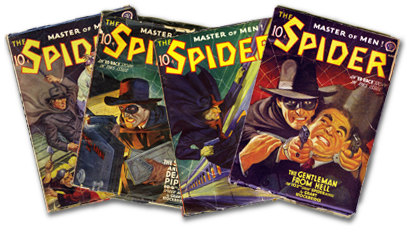
All pulp – no super-hero – blazing 45’s
Try as I might, I couldn’t find any prior Lee or Ditko tales that might have been a template for the character of Spider-Man. None. Lee’s oft quoted statement that he had a long fascination with the pulp hero The Spider, may be true, but there is absolutely no resemblance in origin, weapons, personality or powers between the two characters. It should be noted that Stan’s fascination with the pulp Spider never led him to create a spider figure in the Golden Age when Stan was creating so many characters.
It should be highlighted that the addition of the extra sense that warns of impending danger, first seen in the Fly, seems to have been an original Kirby item, since it was not present in either the Silver Spider proposal, or mentioned in the Jacobson memo. It should also be noted that this insect-sense was not a one-time and then forgotten use, The power was in constant use even after Simon and Kirby left the series. It was a consistent part of the characters profile.

Inset from Fly #16 cover – they can’t control their “insect powers” – Still pre-Spider-Man
Ditko, for his part has acknowledged that the original concept was similar to The Fly, yet he says it was rejected, and changed because it was too identical to the Fly. So I tried to see where they might have changed the character. Try as I might, there is nothing significantly different between the Fly and Spider-Man. Every unique power that Spidey possesses first shows up in the Fly. Why, if they recognized the similarity between the Fly and Spider-Man, didn’t Stan and Steve make some changes except for the origin gimmick?
There are some specific detail differences, however, in these similar powers: The Fly’s super strength is never explained, it’s just a given. Spider-Man’s is specifically described as the “proportional strength” of a spider–a rather unique concept, (and surprisingly never used by any other insect inspired hero, i.e. Blue Beetle, Green Hornet, Tarantula ) and specific enough for me to try to track down to see if this might be an addition attributable to Lee or Ditko. But again, the only example I could find of any one of these three men giving a character the proportional strength of an insect prior to the creation of Spider-Man is found in a Kirby story. In Black Cat Mystic #60 (Harvey Publications, 1957), in a story entitled “The Ant Extract,” a meek scientist discovers a serum that gives him the proportional strength of an ant. Because of his new power, the scientist is feared and ostracized by authorities. (sounds vaguely familiar) Another small, but novel detail, that shows the evolution of the concept, and is traceable to Jack Kirby.
The mechanical weapon as first created by Kirby has been described by Steve Ditko as a web-shooting gun, and later modified by Ditko into a wrist-mounted web shooter. Again, not taking this quote as fact, my research found that the only pattern match to a costume emanated webbing, is found in the Jacobson memo that Kirby had. The wrist shooter as designed by Ditko is a wonderful modification and a stroke of genius, but it is still just a modification–the actual idea of a mechanical web shooter, even by Ditko’s account, was Kirby’s. There is also a time when Steve wanted to have a villain replicate Spider-Man and he chose a web gun rather than a wrist shooter yet no one notices the difference.
In review: every unique physical aspect of the character we know as Spider-Man can be traced back to only one of the three men involved, Jack Kirby. Not only amazingly exact pattern matches, but also a written blueprint that only Kirby had seen. Evidence and modus operandi. If the concept of Spider-Man was all that Kirby supplied, he deserves co-creator credits, but it doesn’t end there.
The next aspect is the character of Peter Parker, and while he is Spider-Man, the role of the alter-ego is to present a sometimes opposing character to the heroes. It is this dichotomy that helps create tension and oftimes humor. It is this aspect that keeps the hero and the story grounded in some semblance of reality.
Peter’s character is portrayed as a nerdy, wallflower science whiz, taunted by his peers for his lack of athletic prowess and social skills. He is rejected by the opposite sex.
Surprising as the aspect seems Ditko-like, after comparing the recent works of the three men, I was able to find a pattern match with only one of them, Jack Kirby. And not just one outlier, but several times.
In the late ‘50s, Kirby was looking for work, his comic book work had dwindled and he thought of getting into the syndicated strips. One of the strips he proposed was titled Chip Hardy. Chip was a young college freshman on a science scholarship. A regular ‘boy wonder’ taunted the other kids. Moose Mulligan, the campus jock, teased young Chip about why he didn’t try out for football, instead of “hiding behind a mess of test tubes”. Other students followed suit and mocked the youngster, labeling all science majors as “squares”. Eventually, this taunting escalated into a physical confrontation between Moose and Hardy, with young Chip getting the better of it, mimicking exactly the character template and early relationship between Peter Parker, Flash Thompson, and the other school mates. While this strip was never published, Greg Theakston has published a few panels in the back of The Complete Sky Masters of the Space Force. (Pure Imagination, 2000).
Another amazing pattern match is to be found in Tales To Astonish #22, (Marvel Pub. Aug. 1961) in a tale titled “I Dared to Battle the Crawling Monster”, one of the many Kirby/Ayers monster stories, possibly dialogued by Larry Lieber. (unsigned by Lee) The hero is a high school student, a scrawny, dorky, bookwormish sort, laughed at by the jocks for his lack of athletic ability, and taunted by the girls. Typically, by the end of the story, it is the bookworm, not the jock who is the hero. Even the visuals of the lead character strongly resemble the Peter Parker character as shown in AF#15.
Puts the lie to Kirby couldn’t do nerdy and scrawny – another scrawny abused older teenager
In the Bruttu story from Tales of Suspense #22, the protagonist was a small beleaguered scientist, taunted about his size all through high school and college, and into his workplace. It was this taunting that drove him to mistakenly become a monster. This milksop character who overcomes his limitations had become a standard icon of Kirby’s fantasy stories.
As to Stan Lee and Steve Ditko, I could not find any earlier templates for the harassed, teen-age, academic style hero. And Lee/Ditko had a several years long collaboration where one might expect this plot element to show up. None, and this, frankly surprised me. There is one aspect of Peter Parker that was consistent to Stan Lee, and that is Peter’s personality. Besides being a science geek, (complete with pocket protector) Peter is shown to be somewhat angst-ridden; doubting of his own worth and unable to fit easily into society. His uneasiness with his new- found powers is atypical of Kirby’s heroes. Kirby’s men were fighters, despite their shortcomings. This inner conflict, and sometimes, outer rage is pure Lee, it is this deeper human psychological aspect that Lee imbued into all of Marvel’s heroes. It is the difference between Ben Grimm of the Fantastic Four, and Rocky Davis of the Challengers of the Unknown.
Spider-Man, the alter-ego as an orphan was a constant among Kirby creations. I swear that I can’t think of a singular Kirby hero that had parents. Even those not specifically called orphans never had parents intruding their exploits. Some have said that Uncle Ben was originally a gruff, ex-military man not happy with his milksop nephew. And that Jack would never have done that type of relationship. Yet they seem to forget that the adoptive parents of the Fly (yes, the same Fly) were very hard on the child, even to the point of beating him, and by issue #4-5 changed completely into proud and supportive parents.
The villain of AF #15 is a colorless petty crook who has assaulted Spider-Man’s guardian-his uncle. His sole purpose is to create the crisis, which forces the hero into action. This match up is also found in the Fly’s origin. The Fly’s first use of his powers is to bring to justice, a petty crook who had assaulted Tommy’s guardian. This was both characters’ sole appearance.
J. Jonah Jameson is interesting. He is the adult blustering pain in the ass that constantly harassed the hero that Kirby used all the time, from original Captain America to the Shield, and Hulk on. The role of newspaper editor is an interesting one. Jack Kirby had just recently done a fantasy story (Amazing Adventures #4 “I Am Robot X”) where a blustery newspaper man tries to use his media power to destroy the hero; coincidently his name was also a three part Waspy name with an initial; Charles J. Wentworth. Like Jonah, he uses the power of the press to gin up public anger to destroy his enemy for his own selfish reasons. It was also one of Kirby’s sentient robot stories-another oft used idea. It’s a small detail, but J. J. Jameson’s newspaper was the Daily Bugle; a name that Jack used several times during the Golden Age, he even used this title in a newspaper blurb in Fantastic Four #2. Small detail, but telling as to who provided details.
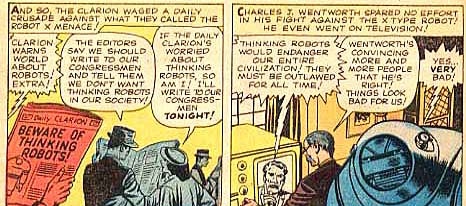
Before Spider-Man developed money trouble, the Fantastic Four had their own run in with debt. They also had an issue with very bad press and hatred by the public. These ideas didn’t start with Spider-Man. The use of a wrestler as a foe against a super-powered hero was not new. Jack had used colorful wrestlers at least five times as foils in his stories dating back to Golden Age. He also put that bit into the FF, with the Thing taking on wrestlers as a comic touch.
The radiated spider is unique, unique to Kirby that is. Just before the AF#15 story Jack drew a fantasy story that involved a common spider that mistakenly gets irradiated and mutates. Jack used radiated insects several times before Spider-Man. This makes a nice change from the original ring gimmick
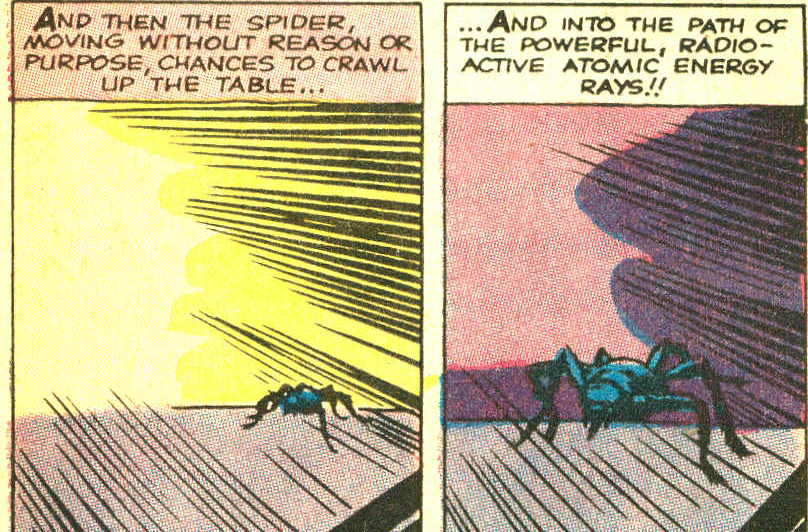
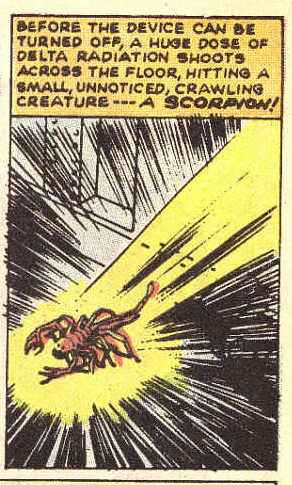
As to the characters, are my findings beyond the norm at Marvel at the time? I don’t think so. That Kirby constantly evolved and morphed characters and concepts is not an astounding statement. Just look at the examples. I showed for The Thing, and the Hulk, as well as Thor and Ant Man. Jack’s whole history at Marvel is filled with his taking prior concepts and reworking them to meet current needs.
That Stan Lee would take these stock Kirby characters and give them distinct personalities, foibles, and conflicts, soap opera style melodramatic continuities, and hip dialogue is also not really in doubt. I would go so far as to say that both aspects are equally important as to why Marvels’ sales rose.
That the character of Spider-Man as originally created was a Kirby concept is irrefutable, even without the Jacobson memos the patterns are obvious, with the memos it’s undeniable. There is also strong evidence that, the templates for Peter Parker’s maligned science whiz character, and some of the supporting cast was supplied by Jack Kirby.
The coincidences needed for Stan Lee or Steve Ditko to have come up with these exact elements, absent Jack Kirby, are astronomical. If this was all that Kirby provided to Stan Lee, he would deserve credit, but there is more to creating a character: One must also come up with a story line that showcases the new character, and it is here that the coincidences become positively mind boggling.
The plot of Amazing Fantasy #15 is simple, yet unique: An orphaned teenage boy receives super-powers during a scientific experiment. After gaining his powers, a loved one is killed due to his inaction. This remorse leads him to vow to never let it happen again, thus becoming a hero.
Again, after cross checking stories by these three men, it became obvious that in structure and theme, the basic plot for Spidey’s origin came from one of the three persons involved: Jack Kirby.
The first plot element has to do with an orphaned, older teenager, who gets super powers via a scientific experiment, and this is intriguing. Even though I tried to approach this in an entirely objective manner, I still had some preconceived notions of both Kirby’s and Ditko’s proclivities. One of these was that it was Ditko’s nature to use older troubled teenagers for his heroes, while it was Kirby’s nature to use younger kids. So strong is Ditko’s aura surrounding Spider-Man that I just assumed that it was a Ditko trait, but I was not able to track down a single use of older orphaned teenagers, troubled or not, by Steve prior to Spidey.
What shocked me was how easy it was to find the template for the orphaned older teenaged hero, and a title that would provide key elements in piecing together the puzzle. Surprisingly, it was in a title by Jack Kirby.
In The Double Life of Private Strong, (Archie Publications 1959) (not coincidentally the companion title to The Fly) the hero, Lancelot Strong, aka The Shield, is an orphaned high school senior, and like Spider-Man, his surrogate parents were gentle, compassionate, and supportive. His powers were the result of a scientific experiment.
Around this same time, Kirby was also working on the proposed newspaper strip, Chip Hardy, with a teen-aged science whiz hero. In fact, from about 1959 on, just about all of Kirby’s youthful heroes would be older teenagers, and most orphaned. Johnny Storm, Rick Jones (both predating Peter Parker) and the X-Men all fit into this mold.
The plot of Amazing Fantasy #15 is simple, yet unique: An orphaned teenage boy, raised by loving relatives, receives super-powers during a scientific experiment. After gaining his powers, a loved one is killed due to his inaction. This remorse leads him to vow to never let it happen again, thus becoming a hero.
Again, after cross checking stories by these three men, it became obvious that in structure and theme, the basic plot for Spidey’s origin came from one of the three persons involved: Jack Kirby.
There is also a Marvel romance story drawn by Kirby where a young girl is torn between the shy, nerdy, writer and the BMOC football star Flash Thompson. She chooses the shy guy who saves the prom. It’s interesting to see the name move from one jock to the other. Several fantasy stories by Kirby had older teenagers as protagonists.
The next element is very important: After gaining his powers, the hero loses a loved one due to his inaction, thus providing the impetus for becoming a hero. This may be the critical element that separates Spider-Man from almost all other heroes- yet it’s right there in The Double Life of Private Strong. While rushing off to test his newfound powers against a rampaging alien monster, The Shield, (Lancelot Strong), in his teen exuberance, ignores and leaves his best friend Spud in harms way.
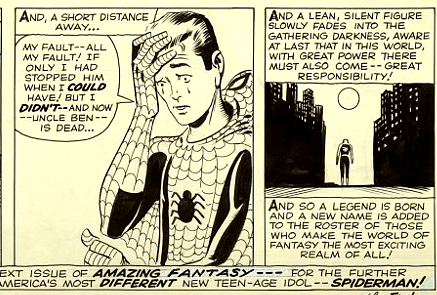
After defeating the brute, the Shield returns to celebrate his triumph only to learn that the monster has killed Spud. The distraught Shield blames himself, and vows that it will never happen again. Similarly, Spider-man, in a moment of conceit and arrogance, ignores a thief, only to learn that that same thief would go on to kill his Uncle, which in turn, spurs him into action. He then vows that it will never happen again.
Harry Mendryk, an Simon & Kirby historian disagrees. From a blog post; “ Some comic experts have tried to equate this with the death of Uncle Ben in the Spider-Man origin story. However it just does not wash. Uncle Ben’s death was the result of Spider-Man’s unwillingness to intercede in a crime while Lancelot was very much fulfilling the role of a hero when he left Spud. Further it is not clear that Spud would in fact die as the policeman says that they will try to save him. And if that was not enough, Lancelot does not seem that remorseful”
I don’t know when I became “some comic experts” but that’s OK. Harry says that the details are different; of course they are, the details always changed, but the underlying concept was the same. The deaths were the result of teen age immaturity. Whether it’s interceding in a crime, or simple exuberance, the hero chose to overlook his responsibilities, and promises to do better. And Harry is wrong, Spud did die, that little blurb looks like a comic code add on, since it doesn’t point to anyone, and Spud never shows up again. Lancelot is shown just as remorseful as Peter Parker; the remorse is shown in the text. The use of the word “if” is how we say remorse. It’s the wish to have another chance to change history. Yes I do accept that Stan Lee’s words are more dramatic, but the meaning is the same. The concepts were the same. A friend is lost, and the hero now learns he must be more responsible.
So in one book, done less than three years before Spider-Man, Kirby used most of the critical plot elements that would show up a few years later in Spider-Man. Certainly Spider-Man’s is more melodramatic as one would expect from Stan’s dialogue, but the basic plot mirrors Private Strong. The panels where the boys mourn the loss of their loved ones are almost eerie in their similarities. So going by pattern matches, it appears we have the hero and villain from the Fly combined with the origin outline of the Shield.
This cross-pollination of a character from one story, and a plot from another is classic Kirby. He had touches of genius, but during the late 1950’s to mid-sixties, his characters and plots were interchangeable. His storytelling was very formulaic. He had archetypal heroes, a small list of stock villains, and, a set selection of plots. He mixed and matched these regardless of genres. His approach to comics was sort of a Chinese take-out menu, one from column A and one from column B. In legal lingo, Kirby was a chronic repeat offender. Kirby’s touches are repetitive and easily identifiable. This pattern can also be found on the Mighty Thor.
For Spider-Man, Kirby took the basic character traits (insect), and the villain (meaningless, petty crook) from the Fly, and the origin gimmick (scientific, older teen), and the dramatic ending (mourning a lost friend) from the Shield.
For Thor, Kirby reversed himself, taking the origin element, (finding of a mystical artifact that transforms a timid human to a colorful hero) and ending, (transformation back to hapless human) from the Fly, and the villain (rampaging aliens) from the Shield, plus borrowing the hero from an earlier DC fantasy story. (Tales of the Unexpected #16)
Thor, and Spider-Man appeared on the stands simultaneously. Thor had the earlier story number. Facts, and patterns says the Confessor, plus look for what doesn’t fit.
Stan Lee and Steve Ditko say they rejected the original plot because of its similarity to The Fly, and created their own. The idea that they would reject one Kirby plot and then replace it with another Kirby plot makes no sense, it simply doesn’t fit. These two men had their own influences and patterns, and if they were to sit down and come up with an original origin, it would not have mirrored a recent Kirby plot, especially if they were specifically looking to avoid the appearance of a Kirby plot. It seems that when Ditko told Lee about the similarity to the Fly, Stan, according to Ditko, called Kirby, who then cobbled together a new origin gimmick based somewhat on the Shield. It appears that Stan and Steve took Kirby’s plot, added in Peter’s personality, some of the supporting cast, and maybe the details involving the wrestler and show business, but the basic plot was all Kirby. The idea that Kirby would plot the origin of a new character is the rule at Marvel in the early ‘60s. It would actually be an anomaly if Kirby “hadn’t” provided the origin.
But it doesn’t stop there. Not only does it appear that Kirby provided the plot for AF #15, it appears that he also assisted in plotting some of the following Spidey stories. The second and third Spider-Man stories have plot elements taken directly from the second and third Private Strong stories. That’s correct; the first three Spidey stories mirror the first three Shield stories. Shouldn’t be a surprise since the evidence of the job #’s show they were drawn in quick succession for future issues of Amazing Fantasy and were shelved when the series was cancelled.
The second Shield story involves the hero tracking down a Communist spy attempting to steal scientific secrets; the villain tries to escape in a submarine that the hero has to put out of action. This is also the plot of the Chameleon story, in Amazing Spider-Man #1. Yes there were detail differences just as one would expect, but the underlying plots are the same. The silliness of an enemy submarine in local waters is too absurd of a detail to think it unrelated.
The villain as a master of disguise was used by Jack Kirby in the first, second, or third story of just about every series he did between 1956 and 1963. (I mentioned he was predictable) It is found in his first Green Arrow story, (Green Arrows of the World, Adventure Comics #250, DC Pub.1958) the second Yellow Claw story, (The Mystery of Cabin 361, Yellow Claw #2, Marvel 1958) the third Dr. Droom tale, (Doctor Droom Meets Zemu, Amazing Adventures #2, Marvel 1961), the second Fantastic Four story, the second Ant-Man story, and the third Thor story, all preceding AS#1, plus numerous fantasy tales.
The specific element of a villain impersonating a hero in order to infiltrate, and/or incriminate him in a crime is one that Kirby used often. Prior to Amazing Spider-Man #1, it can be found in Fighting American, (Three Coins in the Pushcart, Fighting American #7, Prize Comics, 1954) Green Arrow, (Adventure Comics #250) and most recently in Fantastic Four #2. This theme would also be used in the test appearance of Captain America in Strange Tales #114.
In the third Shield, and Spider-Man stories, we are introduced to the recurring pain-in-the-ass authority figure/ nemesis – the one who always gets hoisted on his own petard; a Kirby icon, dating back to Captain America. The harasser being a media mogul personality shows up in a fantasy story a few months earlier. In both stories the adult child of that authority figure gets into a jam and needs the costumed hero to save him or her. In the Shield’s case, it’s the daughter of the general in charge of the base he is assigned to after being drafted. After being trapped in a runaway tank, the Shield must save her. In Spider-Man’s story, it’s the son of the editor of the newspaper who hires Peter Parker, and he is trapped in a runaway space capsule that Spider-Man must rescue. Even after saving their offspring, neither of the authoritarian figures considers the hero a particularly positive force, and both think the alter ego character is a bumbling idiot. In between the Shield, and Spider-Man, Kirby also used this gimmick in the Hulk. The scene where Spider-Man rides the spaceship is replacing a module mirrored closely to a scene in Sky Masters where Sky had to rescue an errant space ship by replacing a module. Even the rescue of the capsule uses a then unknown to the general public procedure that Jack had shown in his Sky Masters strip.
What are the odds, if Kirby didn’t assist on the plots, that the first 3 Spider-Man stories would mirror the first 3 Shield stories, plus elements from Sky Masters? Wouldn’t one think that Stan Lee, and Steve Ditko would have their own plotting patterns?
Astoundingly, the second issue of Amazing Spider-Man continues in this same vein. The Vulture story from AS#2 is interesting because not only does it have plot elements from an earlier Kirby story, the bad guy is an exact duplicate of the villain from that same Kirby story. In the first Manhunter story, (Adventure Comics #73, DC Pub. 1942) Kirby introduced The Buzzard, who, in an uncanny parallel to the Vulture, is a skinny, stoop shouldered, hump-backed, beak nosed maniac, dressed in a green body suit with a feathered collar that encircles the neck. Both men have the power of flight, the Buzzard by flapping his cape, and the Vulture via mechanical wings, and an anti- magnetism unit.
Both men’s schtick is to openly challenge the authorities and the media by boasting of their evil plans before they commit them. The Buzzard goes so far as to actually kill a reporter to deliver his message; the Vulture (in post code times) simply throws a rock through J. Jonah’s window.
The Tinkerer story in AS#2, has a very interesting hook, a plot element where a radio is doctored and infiltrated into scientists and government officials’ houses in order to spy and/or control them. This is not some generic scheme, but a very detailed and specific plot element used by Jack Kirby several times. The earliest use is in Captain America Comics #7, (Marvel Pub. Oct.1941) in a story titled “Horror Plays the Scales”. Kirby again used this element in a crime story from Headline Comics #24, (Prize Pub. May 1947) titled “Murder on a Wavelength”.
The alien aspect of this Spidey story appears adapted from a Kirby, Dr. Droom story. In his third story, (Doctor Droom Meets Zemu, Amazing Adventures #3, Marvel 1961) Droom is following a suspicious character and overhears a plan by aliens in which one will infiltrate humanity and lay the groundwork for an alien invasion. Spider-Man’s capture and escape method seem to be lifted from a Challengers of the Unknown story. (The Human Pets, Challengers of the Unknown #3, DC Pub.1958) All of these stories are structured in typical Kirby style, with little characterization, all out action endings, devoid of any of the subtlety, pathos, or irony usually associated with Lee/Ditko offerings.
It’s a good time for me to mention something I call “Kirby’s silly science.” As identifiable as fingerprints, we all recognize it: scientific plot elements so ridiculous in their implausibility, yet so exciting visually, and conceptually, that it’s immediately acceptable; Mr. Fantastic, reaching up and catching a nuclear tipped Hunter missile in full flight, and throwing it miles away into the bay. The Submariner; in the freezing void of space, leapfrogging, from meteorite to meteorite, only to land on Dr. Doom’s spaceship, unstable molecules, and such.
The early Spider-Man stories were full of this pseudo-scientific stuff. In the story involving J. Jonah Jameson’s son trapped in the space capsule, we first see NASA trying to snare the disabled capsule in a net suspended from a parachute, when this fails, Spider-Man, straddling a jet, snares the space capsule with his web and rides it like a bucking bronco, completely overlooking the fact that space capsules orbit far above the range of a jet, and the extreme heat generated during re-entry would fry a human being, even one with Spider powers.
This feels like Kirby’s silly science to me; in fact, it is reminiscent of a scene in Sky Masters where they try to rescue an errant space capsule with a hook attached to a jet, combined with a satellite repair story centering around the hero replacing a module on a renegade satellite, also found in Sky Masters.
In Amazing Spider-Man #1 the Chameleon comes up with a mechanical means to communicate with Spidey due to his Spider instinct. In the third Ant-Man story Jack shows the villain Egghead unexplainably come up with a way to instantly communicate with the insects– getting to Ant-Man. Ant-Man did the same thing with a screwdriver in his origin. This same unexplained bit also shows up in Spidey #5 when the villain Dr. Doom mysteriously comes up with a way to communicate with the insectoid Spider-Man. Jack’s scientists were fast, handy and smart. It was dumb but effective as a plot element. It was a Jack Kirby bit of iconography.
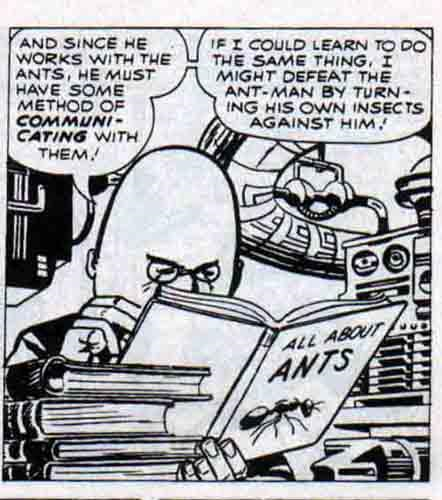
Another facet of Kirby’s silly science, and plotting pattern, is the anti-climactic ending, where the scientist hero, in one panel, whips up some bit of gadgetry that defeats a villain who has been beating his brains out for the previous 15 pages. Kirby’s monster tales are full of them as opposed to Lee and Ditko’s more cerebral ironic endings.
Challengers of the Unknown’s Professor Haley was good at these instant cures, and the FF’s Reed Richards was the master, but early on, Peter Parker stood toe to toe with them. In the first Vulture story, from Amazing Spider-Man #2, after getting his hat handed to him, Peter Parker, based on nothing but a hunch, theorizes that the Vulture’s powers must be magnetic and whips up, in one panel, an anti-magnetic device with his handy dandy screwdriver. How Kirbyish can you get? Similarly whipped up out of nothing elements occur in the first Doc Ock, (a super acid) and the first Lizard story. (an antidote) The super acid bit was also used earlier in a Challengers story. This kid was good!
Compare this to the atmospheric, cerebral, and quietly ironic solutions and climaxes that Lee and Ditko specialized in on their sci-fi/horror tales of this period. This deus ex machina style ending is not part of their repertoire, it simply doesn’t fit.
To Kirby, scientists were scientists; he made no real distinction between the disciplines. In one story the hero was a physicist, the next a chemist, perhaps a biologist or a metallurgist, whatever was needed for the story. Hank Pym, aka Ant-Man, was equal part entomologist, chemist, cybernetician, and machinist. Reed Richards was master of all sciences, and Peter Parker, though a high school student was equally as versatile. After receiving the spider powers, this kid went home and with his Mr. Wizard Home Chemistry Lab created a formula for a web, and the means to propel it. Then in the Vulture story he suddenly becomes a physics master, and invents an anti-magnetic device. In the Tinkerer tale, he is assisting an electronics genius, and up against the Lizard, Peter’s become an expert in serums and antidotes. This boy was truly amazing! It’s a shame he gave all that scientific ability up to become a news photographer. Kirby’s handiwork is all over the early stories.
Thankfully, these pseudo-science elements soon ended, and I’m thinking it happened when Jack stopped assisting Stan on Spider-Man plots, and Ditko took over. So it seems clear that Kirby’s participation with Spider-Man extended further than just a rejected proposal. It appears that he not only created the character, he also assisted greatly in the origin and early story lines and added many early plot elements.
Again, is this out of character? No. Kirby helped Stan with the plotting of several characters even when not specifically drawing them. We know he helped out Wally Wood on Daredevil and Don Heck on Iron Man. Why wouldn’t Kirby assist Stan on Spider-Man? The early Marvel titles and characters were never considered private domains. Stan certainly had no compunction about Kirby doing the first 2 covers, or a back up story.
Remember Stan Goldberg’s words. “Jack would sit there at lunch, and tell us these great ideas about what he was going to do next. It was like the ideas were bursting from every pore of his body. It was very interesting because he was a fountain of ideas.”
So much for actual research, now let’s speculate a little further. In mid-1961, Martin Goodman noticed that the sales of the Atlas monster books were slowing down, and while looking for a replacement genre, he realized that DC seemed to be having some success with super-heroes. He decided that Marvel should take a hesitant step in that direction, and either he or Stan Lee talked to Jack Kirby, who had a 20-year history of creating super-heroes. They decided on a team concept with a twist, the characters would not always get along. Kirby went home and cobbled together a story using parts of his last 2 team series, the Challengers of the Unknown, and his recent syndicated strip Sky Masters of the Space Force, and he presented it to Stan Lee. Stan added in the personalities, the background details, the speech patterns, and Fantastic Four was born.
Seeing that the FF was selling but still a little wary of jumping full bore into the super-hero market, Stan next talked with Jack about using an Atlas-style monster as a hero. So Kirby went home, matched together a recent Atlas monster with a Sky Masters plot element dealing with a scientist saving a kid from a rocket blast, threw in his radiation-caused mutation concept he had used since Blue Bolt days, and you have the Hulk. Again Stan added in the soap opera, the personalities, the linear continuity, and the human aspects he specialized in.
Martin, seeing that both series were selling, decided to go balls to the wall into the super-hero genre, complete with costumes, secret identities, and all the trappings. Stan again went to Jack and asked him if he had any other concepts lying around. Kirby remembered a recent story revolving around the mystical hammer of Thor and retconned it into a superhero. Kirby, doing just as he had with the FF – went back to the last two pure super-hero series he had worked on, took the character aspects from the Fly, plus elements suggested by Jacobson, mixed it in with the plot from the Shield, used the original title from the unused Simon proposal, et voila! Spider-Man!
It is possible, in fact probable, that when Kirby presented this proposal to Lee, Stan had some reservations because his vision of the character was a little different. It didn’t matter, because Kirby was too busy to draw this feature anyway—Stan, and the new artist could make the changes. They could flesh out, and add their own take on the characters–Kirby was too busy: He was drawing the FF and the Hulk full time, and besides Spider-Man, he had simultaneously worked up Thor, and Ant-Man.
All this fits in with the very first account of how Spider-Man came to be. Remember, Stan said that Kirby was too busy and he (Lee) chose Steve Ditko to draw the feature after the concepts were done, and it fits in with Ditko’s first recollections. What doesn’t fit is Stan Lee’s story of how when he saw Kirby’s version of Spider-Man, that the vision was too godlike, too buffed and perfect physically. Kirby at the time was drawing all his people thin and gangly. (look at the original Thor) If Stan didn’t like Kirby’s version, then why did he have Jack draw the first two covers? And it’s funny, but Jack had no problem drawing a slender, Spider-Man on the covers. But does this fit in with what we know about how Marvel worked in the early 1960s?
I think it does. Marvel had a modus operandi also. Evidence shows that Kirby helped out on just about every new project, even the ones he didn’t draw. (origin plot, and costume design for Iron Man, splash page, cover and plot elements for Daredevil, etc.)
Why wouldn’t Jack be involved similarly in any Ditko projects? There were no separate fiefdoms at Marvel at this time. Ditko worked with Kirby, and Kirby certainly helped out with the first two covers, he provided an advertising blurb in the first issue, he did a back-up story in #8. I would not be surprised if Ditko gave some plot ideas for the FF. Jack did cover retouches and corrections. He also did a Spider-Man crossover story in Fantastic Four Annual #1 in the summer of 1963, and in Strange Tales Annual #2, Fall 1963, both of which appeared before AS#6. The Fantastic Four was intertwined with Spider-Man like no other Marvel series.
In the early days of Marvel, there was no sense of separate books; everyone contributed to every series. It’s amazing, but I don’t think coincidental, that every member of the bullpen was multifaceted: Lee would edit, write, and script; Leiber would pencil, ink, and write; Kirby would pencil, create, and plot; Ditko could pencil, ink, and plot, etc. There seems to have been a true all-for-one atmosphere early on in the bullpen. I actually think this is why these men were the ones picked when Stan Lee regrouped Atlas in 1959. It was this flexibility, and multi talented nature that allowed Stan to create the Marvel method of storytelling.
I think the most important thing to take away from the stories of Kirby helping out Wallace Wood, and Don Heck is that it wasn’t unusual; it was just another day at the office. It was Kirby’s nature to help out.
So, to wrap up, we have the title of the series, which was likely contributed by Kirby. We have the main character of the series surely created by Kirby, with an assist to Sid Jacobson. And we have the origin, and first couple of stories, most likely plot assisted by Kirby. How much more does it take to deserve co-creative status?
Never the less, I am not on any campaign to get Kirby an official credit on Spider-Man. Ditko/Lee works just fine for me. Yet for historical purposes, I do believe that his contributions should be recognized.
So does this mean that Stan Lee, and Steve Ditko are lying? I don’t think so. I think this is an example where each one is telling the truth from their own perspective. Jack Kirby was a conceptualist, an idea man, he felt that creation was the coming up of new ideas. Stan Lee is a writer, he’s a word man, he naturally feels the act of creation starts with the fleshing out of the personality and giving voice to the character. And Steve is an artist, his idea of creation is the giving of form, and texture, and atmosphere to a shapeless thought. To thine own self be true, and I think they are.
In my opinion, Spider-Man is the classic example of a true collaboration, omit any one of the three men involved and you end up with a weaker, or non-existent creation.
If just Kirby and Lee had worked on the title, we would have invariably seen it head into the all-out adventure, or cosmic/mythic realms of Kirby’s other titles, thereby losing out on the gritty, earthiness Ditko added. If Lee and Ditko had created it from scratch, we would have had a hero more like the cerebral Dr. Strange, lacking the action/adventure facet that Kirby added. The combination helped eliminate the individual excesses, while keeping the best of each.
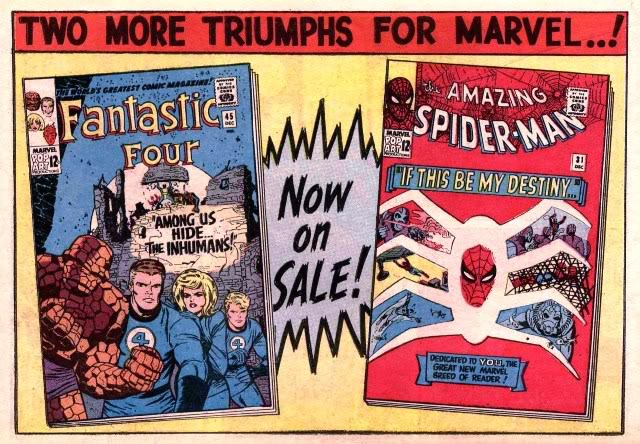
Always together
Because Kirby’s participation ended quickly doesn’t detract from his role in the creation, without his character concepts, and strong action based foundation, Spider-Man might never have found that perfect mix of the psychological and physical aspects. Left to his own devises, Ditko’s characters and stories usually lack the testosterone based fun fantasies, that pure physicality, that the super hero genre demands. His characters thought too much, and acted too little.
And without Stan Lee, in my opinion, we would have been without the single most vital ingredient that made Spider-Man the most unique character in comics. Human frailty!!! More than any other character he worked on, Stan identified with Peter Parker. His vision of the everyman as hero made Spidey the most conflicted, the most human, and the most unique hero ever created. His blueprint was the perfect recipe for a super hero in the post war era. It was an age when the common man, no longer felt in control of his own destiny. Spider-Man was not just fighting bad guys; he was fighting our doubts, our rages, and our feeling of helplessness. He, like most people, (especially the teens reading his books) was looking for their role in society, and was turned away at every stop. Stan Lee made Spider-Man one of us. This is why Spidey not only continued, he thrived, long after both Kirby and Ditko, no longer had any input.
Together we got the perfect blend of Kirby’s solid histrionics, Ditko’s philosophic atmospherics, and Lee’s melodramatic human voice.
It just doesn’t get any better folks.
Who created Spider-Man? There’s room for all three
Previous – 18. New Beginnings | Top | Next – 20. Bullpen? Bullshit!!


